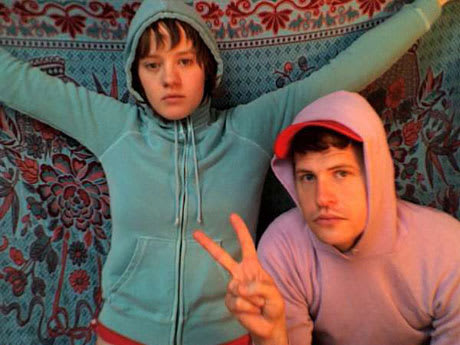Brooklyn-spawned plug-and-play duo High Places didn't offer a very visually-arresting setup: Mary Pearson and Robert Barber stood side-by side, both fiddling with their respective multi-faceted electro kits. So why was the sparse-but-front-loaded Horseshoe crowd so rapt throughout?
High Places capitalized on two things: increasingly alluring pacing and an inherently compelling sonic ethos. Presumably organic, the former saw the band begin slowly, both musically and aesthetically. From the outset, neither Pearson nor Barber moved much. However, as the set and sweat progressed, they incrementally upped the tempo while gradually starting an onstage dance party. This alone wouldn't have elicited such fervent reaction from the crowd, but they played songs too (always a nice touch).
Centred on a simple notion, High Places' tracks utilize a push-and-pull relationship. They position Pearson's ethereal voice - albeit saturated by echo effects - within dense layers of disparate sounds. In a live setting, it's an enthralling dynamic.
Throughout, her pretty lilt flirted with a percussive wall while Barber tried his hand at countless rhythmic concoctions. Moving from half-synthesized calypso beats - replete with the best faux-steel drum ever - to cowbell-evoking hammering, he showed an impressive range.
Jubilantly, "Vision's the First" was surprisingly tropical. "Shared Islands," which evoked Animal Collective's "For Reverend Green," exploded, and closer, "Sandy Feat," joyously evoked "Iko Iko" (about time that someone inadvertently did that).
Set highlight and penultimate track, "Universe," towered above its predecessors, starting with the typical wall of sound, but then cathartically isolating individual elements (i.e. a tropical riff, Pearson's voice, or a lonely, repeated drum beat). Yes, it employed the usual High Places tricks, yet expanded upon them. The result was a mix between Autoamerican-era Blondie and Strawberry Jam-era Animal Collective (admittedly closer to the latter).
Despite the wealth of sounds, the relationship between Barber's creations and Pearson's voice didn't leave all that much room to manoeuvre. As a result, the gig's syntax eventually saw various numbers flow together too familiarly. Luckily, the set was succinct enough to curtail most burgeoning third-act ennui.
High Places capitalized on two things: increasingly alluring pacing and an inherently compelling sonic ethos. Presumably organic, the former saw the band begin slowly, both musically and aesthetically. From the outset, neither Pearson nor Barber moved much. However, as the set and sweat progressed, they incrementally upped the tempo while gradually starting an onstage dance party. This alone wouldn't have elicited such fervent reaction from the crowd, but they played songs too (always a nice touch).
Centred on a simple notion, High Places' tracks utilize a push-and-pull relationship. They position Pearson's ethereal voice - albeit saturated by echo effects - within dense layers of disparate sounds. In a live setting, it's an enthralling dynamic.
Throughout, her pretty lilt flirted with a percussive wall while Barber tried his hand at countless rhythmic concoctions. Moving from half-synthesized calypso beats - replete with the best faux-steel drum ever - to cowbell-evoking hammering, he showed an impressive range.
Jubilantly, "Vision's the First" was surprisingly tropical. "Shared Islands," which evoked Animal Collective's "For Reverend Green," exploded, and closer, "Sandy Feat," joyously evoked "Iko Iko" (about time that someone inadvertently did that).
Set highlight and penultimate track, "Universe," towered above its predecessors, starting with the typical wall of sound, but then cathartically isolating individual elements (i.e. a tropical riff, Pearson's voice, or a lonely, repeated drum beat). Yes, it employed the usual High Places tricks, yet expanded upon them. The result was a mix between Autoamerican-era Blondie and Strawberry Jam-era Animal Collective (admittedly closer to the latter).
Despite the wealth of sounds, the relationship between Barber's creations and Pearson's voice didn't leave all that much room to manoeuvre. As a result, the gig's syntax eventually saw various numbers flow together too familiarly. Luckily, the set was succinct enough to curtail most burgeoning third-act ennui.
